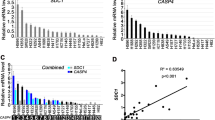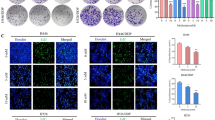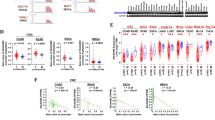Abstract
Silkworm cocoon was recorded to cure carbuncle in the Compendium of Materia Medica. Previous studies have demonstrated that the supplemental silk protein sericin exhibits anticancer activity. In the present study, we investigated the effects of silk fibroin peptide (SFP) extracted from silkworm cocoons against human lung cancer cells in vitro and in vivo and its possible anticancer mechanisms. SFP that we prepared had high content of glycine (~ 30%) and showed a molecular weight of ~ 10 kDa. Intragastric administration of SFP (30 g/kg/d) for 14 days did not affect the weights, vital signs, routine blood indices, and blood biochemical parameters in mice. MTT assay showed that SFP dose-dependently inhibited the growth of human lung cancer A549 and H460 cells in vitro with IC50 values of 9.921 and 9.083 mg/mL, respectively. SFP also dose-dependently suppressed the clonogenic activity of the two cell lines. In lung cancer H460 xenograft mice, intraperitoneal injection of SFP (200 or 500 mg/kg/d) for 40 days significantly suppressed the tumor growth, but did not induce significant changes in the body weight. We further examined the effects of SFP on cell cycle and apoptosis in H460 cells using flow cytometry, which revealed that SFP-induced cell cycle arrest at the S phase, and then promoted cell apoptosis. We demonstrated that SFP (20−50 mg/mL) dose-dependently downregulates Bcl-2 protein expression and upregulates Bax protein in H460 cells during cell apoptosis. The results suggest that SFP should be studied further as a novel therapeutic agent for the treatment of lung cancer.
Similar content being viewed by others
Log in or create a free account to read this content
Gain free access to this article, as well as selected content from this journal and more on nature.com
or
References
Wu XY, Huang XE. Screening for patients with non-small cell lung cancer who could survive long term chemotherapy. Asian Pac J Cancer Prev. 2015;16:647–52.
Yang J, Zhu J, Zhang YH, Chen YS, Ding LL, Kensler TW, et al. Lung cancer in a rural area of China: rapid rise in incidence and poor improvement in survival. Asian Pac J Cancer Prev. 2015;16:7295–302.
de Oliveira VA, Da ML, De Bastiani MA, Lopes FM, Muller CB, Gabiatti BP, et al. In vitro evaluation of antitumoral efficacy of catalase in combination with traditional chemotherapeutic drugs against human lung adenocarcinoma cells. Tumour Biol. 2016;37:10775–84.
Shen J, Ma H, Zhang T, Liu H, Yu L, Li G, et al. Magnolol inhibits the growth of non-small cell lung cancer via Inhibiting microtubule polymerization. Cell Physiol Biochem. 2017;42:1789–801.
Lei JP, Yuan JJ, Pi SH, Wang R, Tan R, Ma CY, et al. Flavones and lignans from the stems of wikstroemia scytophylla Diels. Pharmacogn Mag. 2017;13:488–91.
Aramwit P, Siritientong T, Srichana T. Potential applications of silk sericin, a natural protein from textile industry by-products. Waste Manag Res. 2012;30:217–24.
Kunz RI, Brancalhao RM, Ribeiro LF, Natali MR. Silkworm sericin: properties and biomedical applications. Biomed Res Int. 2016;2016:8175701.
Yerra A, Mysarla DK, Siripurapu P, Jha A, Valluri SV, Mamillapalli A. Effect of polyamines on mechanical and structural properties of Bombyx mori silk. Biopolymers. 2017;107:20–27.
Du S, Zhang J, Zhou WT, Li QX, Greene GW, Zhu HJ, et al. Interactions between fibroin and sericin proteins from Antheraea pernyi and Bombyx mori silk fibers. J Colloid Interface Sci. 2016;478:316–23.
Unajak S, Aroonluke S, Promboon A. An active recombinant cocoonase from the silkworm Bombyx mori: bleaching, degumming and sericin degrading activities. J Sci Food Agric. 2015;95:1179–89.
Kato N, Sato S, Yamanaka A, Yamada H, Fuwa N, Nomura M. Silk protein, sericin, inhibits lipid peroxidation and tyrosinase activity. Biosci Biotechnol Biochem. 1998;62:145–7.
Zhaorigetu S, Sasaki M, Watanabe H, Kato N. Supplemental silk protein, sericin, suppresses colon tumorigenesis in 1,2-dimethylhydrazine-treated mice by reducing oxidative stress and cell proliferation. Biosci Biotechnol Biochem. 2001;65:2181–6.
Kaewkorn W, Limpeanchob N, Tiyaboonchai W, Pongcharoen S, Sutheerawattananonda M. Effects of silk sericin on the proliferation and apoptosis of colon cancer cells. Biol Res. 2012;45:45–50.
Totten JD, Wongpinyochit T, Seib FP. Silk nanoparticles: proof of lysosomotropic anticancer drug delivery at single-cell resolution. J Drug Target. 2017;25:865–72.
Gupta V, Aseh A, Rios CN, Aggarwal BB, Mathur AB. Fabrication and characterization of silk fibroin-derived curcumin nanoparticles for cancer therapy. Int J Nanomed. 2009;4:115–22.
Prateep A, Sumkhemthong S, Suksomtip M, Chanvorachote P, Chaotham C. Peptides extracted from edible mushroom: lentinus squarrosulus induces apoptosis in human lung cancer cells. Pharm Biol. 2017;55:1792–9.
Cao QZ, Lin ZB. Ganoderma lucidum polysaccharides peptide inhibits the growth of vascular endothelial cell and the induction of VEGF in human lung cancer cell. Life Sci. 2006;78:1457–63.
Oroz-Parra I, Navarro M, Cervantes-Luevano KE, Alvarez-Delgado C, Salvesen G, Sanchez-Campos LN, et al. Apoptosis activation in human lung cancer cell lines by a novel synthetic peptide derived from conus californicus venom. Toxins (Basel). 2016;8:38.
Mcconnell EJ, Devapatla B, Yaddanapudi K, Davis KR. The soybean-derived peptide lunasin inhibits non-small cell lung cancer cell proliferation by suppressing phosphorylation of the retinoblastoma protein. Oncotarget. 2015;6:4649–62.
Welschinger R, Bendall LJ. Temporal tracking of cell cycle progression using flow cytometry without the need for synchronization. J Vis Exp 2015;16:e52840.
Zhu Y, He W, Gao X, Li B, Mei C, Xu R, et al. Resveratrol overcomes gefitinib resistance by increasing the intracellular gefitinib concentration and triggering apoptosis, autophagy and senescence in PC9/G NSCLC cells. Sci Rep. 2015;5:17730.
Yan Z, Zhu Z, Wang J, Sun J, Chen Y, Yang G, et al. Synthesis, characterization, and evaluation of a novel inhibitor of WNT/beta-catenin signaling pathway. Mol Cancer. 2013;12:116.
Ding F, Wang M, Du Y, Du S, Zhu Z, Yan Z. BHX inhibits the Wnt signaling pathway by suppressing beta-catenin transcription in the nucleus. Sci Rep. 2016;6:38331.
Liu C, Gong K, Mao X, Li W. Tetrandrine induces apoptosis by activating reactive oxygen species and repressing Akt activity in human hepatocellular carcinoma. Int J Cancer. 2011;129:1519–31.
Yang CH, Craise LM. Development of human epithelial cell systems for radiation risk assessment. Adv Space Res. 1994;14:115–20.
Zbinden G, Kleinert R, Rageth B. Assessment of emetine cardiotoxicity in a subacute toxicity experiment in rats. J Cardiovasc Pharmacol. 1980;2:155–64.
Sa G, Das T. Anti cancer effects of curcumin: cycle of life and death. Cell Div. 2008;3:14.
Lian Z, Niwa K, Gao J, Tagami K, Mori H, Tamaya T. Association of cellular apoptosis with anti-tumor effects of the Chinese herbal complex in endocrine-resistant cancer cell line. Cancer Detect Prev. 2003;27:147–54.
Sun W, Wang W, Kim J, Keng P, Yang S, Zhang H, et al. Anti-cancer effect of resveratrol is associated with induction of apoptosis via a mitochondrial pathway alignment. Adv Exp Med Biol. 2008;614:179–86.
Russo LC, Araujo CB, Iwai LK, Ferro ES, Forti FL. A Cyclin D2-derived peptide acts on specific cell cycle phases by activating ERK1/2 to cause the death of breast cancer cells. J Proteom. 2017;151:24–32.
Tyagi A, Agarwal C, Harrison G, Glode LM, Agarwal R. Silibinin causes cell cycle arrest and apoptosis in human bladder transitional cell carcinoma cells by regulating CDKI-CDK-cyclin cascade, and caspase 3 and PARP cleavages. Carcinogenesis. 2004;25:1711–20.
Thakur R, Kini S, Kurkalang S, Banerjee A, Chatterjee P, Chanda A, et al. Mechanism of apoptosis induction in human breast cancer MCF-7 cell by Ruviprase, a small peptide from Daboia russelii russelii venom. Chem Biol Interact. 2016;258:297–304.
Li D, Dai C, Yang X, Li B, Xiao X, Tang S GADD45a Regulates olaquindox-induced DNA damage and S-phase arrest in human hepatoma G2 cells via JNK/p38 pathways. Molecules 2017; 22: pii: E124.
Adams JM. Therapeutic potential of a peptide targeting BCL-2 cell guardians in cancer. J Clin Invest. 2012;122:1965–7.
Elmore S. Apoptosis: a review of programmed cell death. Toxicol Pathol. 2007;35:495–516.
Zou Y, Li Q, Jiang L, Guo C, Li Y, Yu Y, et al. DNA hypermethylation of CREB3L1 and Bcl-2 associated with the mitochondrial-mediated apoptosis via PI3K/Akt pathway in human BEAS-2B cells exposure to silica nanoparticles. PLoS ONE. 2016;11:e0158475.
Liu D, Yi B, Liao Z, Tang L, Yin D, Zeng S, et al. 14-3-3gamma protein attenuates lipopolysaccharide-induced cardiomyocytes injury through the Bcl-2 family/mitochondria pathway. Int Immunopharmacol. 2014;21:509–15.
Siddiqui WA, Ahad A, Ahsan H. The mystery of BCL2 family: Bcl-2 proteins and apoptosis: an update. Arch Toxicol. 2015;89:289–317.
Acknowledgements
This study was supported by the National Natural Science Foundation of China (No. 81402481, 11432008, and 11372162).
Author contribution
Zhao Yan, Hong-ping Zhao, Zhong-ling Zhu, and Mei-sa Wang designed the research; Mei-sa Wang, Yi-bo Du, Hui-ming Huang, Shuang-shuang Du, and Shao-yong Chen performed the research; Mei-sa Wang and Yi-bo Du analyzed the data.
Author information
Authors and Affiliations
Corresponding authors
Ethics declarations
Competing interests
The authors declare that there are no conflicts of interest.
Electronic supplementary material
Rights and permissions
About this article
Cite this article
Wang, Ms., Du, Yb., Huang, Hm. et al. Silk fibroin peptide suppresses proliferation and induces apoptosis and cell cycle arrest in human lung cancer cells. Acta Pharmacol Sin 40, 522–529 (2019). https://doi.org/10.1038/s41401-018-0048-0
Received:
Accepted:
Published:
Issue date:
DOI: https://doi.org/10.1038/s41401-018-0048-0
This article is cited by
-
A novel silk fibroin protein–based fusion system for enhancing the expression of nanobodies in Escherichia coli
Applied Microbiology and Biotechnology (2022)
-
Cyclometalated Ru(II) β-carboline complexes induce cell cycle arrest and apoptosis in human HeLa cervical cancer cells via suppressing ERK and Akt signaling
JBIC Journal of Biological Inorganic Chemistry (2021)



